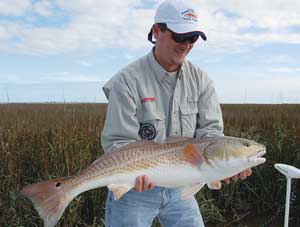
Early April is still cool enough to find good numbers of schooling red drum at shallow inland waters.
Don’t think cool spring weather hurts the fishing barometer at South Carolina’s coastline.
Redfishing continues to product bumper catches throughout the year, including April, as long as anglers overcome a few variables.
Early-spring redfish hangouts are practically in the same backwaters they frequent during the summer months.
The redfish is the largemouth bass of the salt with its aggressive nature and willingness to feed during most periods of the year. Knowing where, why, and how is the mystery.
Nevertheless, Capt. Fred Rourk of Sweet Tea Charters in Georgetown was born and bred in the South Carolina backwaters and seems at times to have a location lock for every redfish swimming the waters of the Palmetto State.
He fishes several times per week throughout the year but relishes the cool weather redfishing.
“You get up close and personal with the fish this time of year, and it’s the only kind of sight fishing you can do inshore for most of the year,” Rourk said.
He works at Tailwalker Marine in Georgetown and sells boats during most of the week, then operates Sweet Tea Charters (800-768-2495 or e-mail fred@tailwalkermarine.com) chasing inshore species during a few afternoons and most weekends.
At Tailwalker Marine, he sells everything from 28-foot Contenders to 16-foot Hewes flats boats. However, Rourk lives out his true passion fishing aboard a Hewes flats boat specially designed to target the skinny waters from McClellanville to Winyah Bay.
Specifically, he chooses the Hewes 18-foot Bonefisher for its single-level deck and ability to float in 6 inches of water. The best redfishing this time of year generally occurs at low tide at the extreme backwaters and that demands a shallow-draft boat.
In fact, a few weeks ago when the water temperature was barely in the 50s, but the air temperatures were in the 60s, Rourk and Chris Whitlock of Pawley’s Island motored across Winyah Bay to the promised land behind Deboradieu Beach.
According to a fellow angler, Don Mussman of Georgetown, large schools of red fish were holding tight in a secluded location behind Winyah Bay, an area familiar to Rourk.
Mussman and Rourk pass location tips back and forth throughout the year. The unseasonably warm air temperatures warm the shallow mud flats a few degrees enticing the fish to bite well for the day.
Rourk motored past numerous oyster beds through a myriad of creeks and tidal flats in search of the destination for the day. Shortly the clatter from the 115 Yamaha ended and Rourk climbed aboard the push platform to begin his stealth approach.
Redfish were holding in super-shallow waters several hundred feet from the boat.
Rourk quietly pushed the Bonefisher into a creek barely wide enough for the boat to pass as the marsh grass brushed the sides of the boat. The water was barely deep enough to keep the boat afloat.
“I can see fish pushing just around the corner and are moving towards the creek intersection ahead,” Rourk said from the top of the push platform at the rear of the boat.
He edged the boat along the shallow, winding creek toward the unsuspecting fish without making the slightest ripple on the water. Rourk continued to whisper as numerous redfish cruised the mud flat just ahead.
“Get ready to cast,” he said.
Suddenly, the boat tipped back and forth and emitted a clunk from a disturbance under the boat.
“I could feel them against my feet,” Whitlock said. “I hope we didn’t spook them.
“We just about have them boxed in,” Rourk said. “Don’t worry about that fish; there are 50 more just in front of you.
“Cast just in front of the exposed oyster bar and work it slow; and I mean slow.”
Whitlock flipped the bail on his Penn GF spin series reel and gently cast a 4-inch Gulp swimming minnow towards the group of redfish holding in just 12 inches of water. He allows the bait to sit motionless for 5 to 10 seconds waiting for the water to rest from his cast.
Then he raised his 7-foot Gloomis rod to the 10 o’clock position, removing all of the slack, and felt for the familiar tension of a bite.
He slowly twitched the end of the rod to give the lure a little bit of action. The clear water revealed several fish just inches away from his Gulp lure, but no offered to take the Gulp lure.
A few twitches later and several revolutions on the reel, the bait was out of the strike zone and away from the fish.
“I had it all over him on a silver platter and he still didn’t bite,” Whitlock said. “Cool weather fishing is slow.
“Keep casting and you’ll find one that will eat,” Rourk said.
Hecast toward another cluster of fish at the opposite bank and restarted the process. As he began to follow the same procedure, he felt a familiar sensation of a fish sucking in the bait.
Go to our archives to read the rest of this story, which first appeared in the April 2007 issue of South Carolina Sportsman magazine. Subscribe to ensure every information-packed issue is delivered right to your door.
Read up-to-date fishing reports and post your own reports by going to our fishing forum. If you aren’t already a registered member of this site, click here to get started today!




Be the first to comment